Exhibition: Listening to Dark Matter // Escuchar la materia oscura
09 March-26 April 2023 Rebecca Collins
In Listening to Dark Matter, artist investigator, Rebecca Collins (1982), invites engagement with scientific uncertainty by staging a series of imaginative encounters with dark matter, an invisible yet abundant particle present in our everyday lives. Notoriously difficult to detect, scientists use technologically engineered advanced conditions to filter interference from light and other particles. Cosmic silence is achieved at Canfranc Underground Laboratory, situated 800m below the Pyrenees, to isolate dark matter from cosmic radiation. Acoustic detectors, at 2.5.km depth, within the Mediterranean Sea listen to collisions between ultra-high-energy particles.
Field visits to aforementioned laboratories inform the content of the exhibition and Collins’ wider investigation ‘Parameters for Understanding Uncertainty’. Sonic-inflected clues inspire the medium in which the exhibition’s work is created. Sound art, with its proclivity for the imagination, can assist in extending engagement with elusive nondescript energies, the nonhuman, and the unknown.
In dialogue with host physicist, David Cerdeño and his Dark Matter Research Group at the Institute for Theoretical Physics, Collins became interested in how dark matter, an ongoing enigma for new physics, is readily available all around us. Whilst we are unable to directly detect, or feel these invisible energetic particles, the presence of dark matter, using artistic means, can be rendered more resonant. Listening to Dark Matter invites us to resist making sense of science, for science already has a plethora of excellent sense-makers, and incites sensorial engagement.
A central tenet of Listening to Dark Matter is to think through how sound operates in the depths of its presentation, rather than as surface representation. The lived and situated experience connected to the processes of sonic-driven scientific experiments remains undocumented in contemporary accounts. To address this in Listening to Dark Matter Collins builds on eco-feminist Donna Haraway’s concept of ‘situated knowledges’ (1988, 581) by privileging reflexive engagement thereby attuning to acts of scientific experiments as experience.
Lend an ear, listen in, and make any other necessary corporeal adjustments to ready yourself for the detection of dark matter. Suspend certainty, engage in the experiential, or at the very least be present to witness the slow arrival of the elusive.
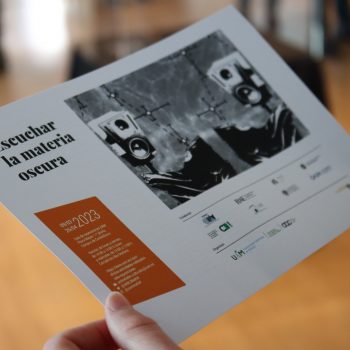

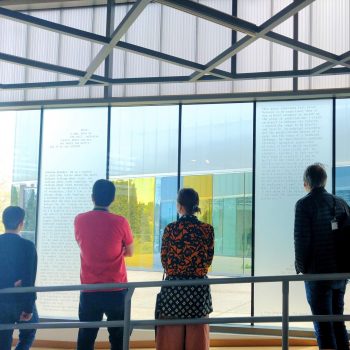
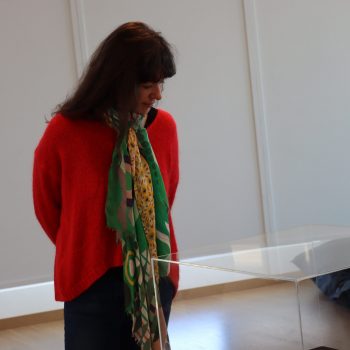
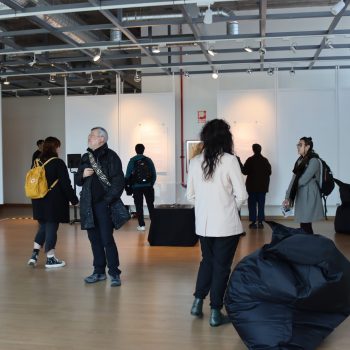

Dark matter constitutes eighty-five percent of matter in the Universe, whilst ordinary matter – including that contained in people, trees, the stars – constitutes only fifteen percent. Dark matter is known, or felt to occur, through observations undertaken by astronomer Vera Rubin (and her team) in the 1970s. Rubin’s investigation measured and revealed how the rotational velocities of stars retained a constant velocity despite their distance. This prevents stars from flying off into the galaxy, a phenomenon explained thanks to an unseen mass holding them there. Contemporary experiments to detect dark matter make use of calculations involving the force of gravity. Dark matter is therefore felt (in physics-related terms) via what it makes occur, how it influences its surroundings, or through traces of what it makes happen. Dark matter is given its name, despite the lack of clarity for what it is, due to its inability to emit or absorb light.
For Listening to Dark Matter, Collins imagines the gallery space to be a large-scale dark matter detector. Particles of the unknown have landed and are rendered resonant in several pieces on display. On the wall a long thin red digital clock calculates the exact number of dark matter particles entering the space over the duration of the exhibition. The idea for this piece, developed by David Cerdeño, uses calculations programmed into an arduino device. On the gallery window a slowly unfolding graphic appears. The design, developed in collaboration with Bricks from the Kiln, departs from drawings made by members of the Dark Matter Research Group. The drawings respond to a prompt proposed by Collins who asked each group member to imagine how the visual evidence to confirm the detection of dark matter might look. Designs include visual reference to graphics featured in data from the DAMA-LIBRA experiment at the Gran Sasso Laboratory in Italy. Published results claim to have observed seasonal fluxes within the detection of dark matter. ANAIS, a Spanish-based experiment located 800m below Mount Tobazo in the Pyrenees at Canfranc Underground Laboratory, aims to replicate these results, however this is yet to be achieved provoking data-based uncertainty within the scientific community.
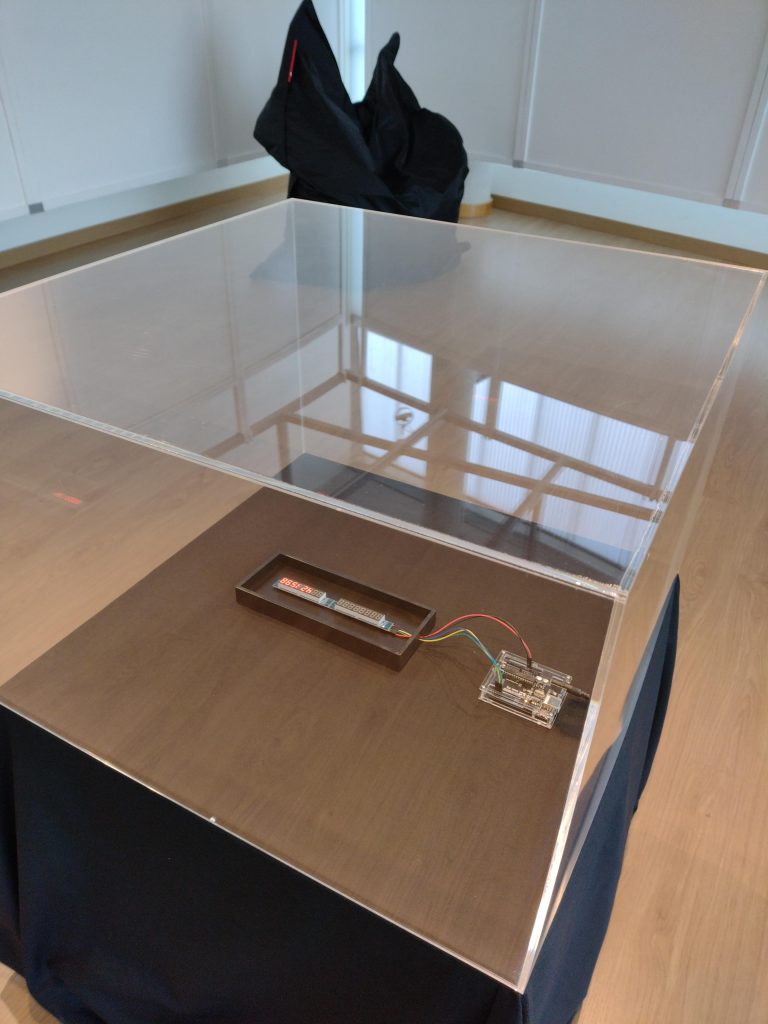
Dark Matter Crossing, 2023 David Cerdeño
Digital display controlled by Arduino board
Dark matter particles are crossing the gallery, right now, in large numbers, however, we cannot feel them. The total amount of dark matter in our galaxy exceeds that of ordinary matter, but it is much more thinly distributed. Studying the motion of stars in the Milky Way and performing numerical simulations of the dark halo, its density at the position of the Earth (and therefore this exhibition space) can be inferred. Using this information and the expected average velocity of dark matter particles, we can determine how much of this elusive substance is crossing us. The numerical display shows, in picograms (one picogram is one trillionth of a gram), the total mass of dark matter particles that have traversed the gallery since the opening of the exhibition.
David Cerdeño is a theoretical physicist working at the Autonomous University of Madrid (UAM) and at the Institute of Theoretical Physics (IFT-UAM/CSIC). His research is focused on Astroparticle Physics, particularly the Dark Matter problem, its relationship with new physics beyond the Standard Model, and the possibility of detecting it.
Assembled in the Astroparticle Laboratory for Elusive Searches (ASTROLABES), and the technical department of the high energy laboratory at UAM, in collaboration with Francisco Gallardo and Pablo Collado Soto.
The Arrival of the Elusive will not be Announced, 2023 Rebecca Collins with Bricks from the Kiln
Translucent Vinyl 12 Pieces 94.5cm x 2m 85cm
Dark matter has been detected in the space of the gallery, the translucent acid vinyl graphics evidence the arrival of the elusive. The design mixes the graph-like representations encountered in physics research papers with textual forms found in concrete poetry. For the creative process Rebecca Collins worked with design collective Bricks from the Kiln sharing performance writing used in Energies not Forms not Figures and drawings created by members of the Direct Detection Dark Matter Research Group at IFT-UAM. The drawings respond to a provocation proposed by Rebecca Collins, where she asked each group member to imagine how the visual evidence to confirm the detection of dark matter might look. The use of concrete poetry, objects composed of words, letters and typeface in which graphic space plays a central role in design and meaning takes its cue from New Tendencies, a Croatian Marxist collective who sought artistic research methods, alongside scientists, as information aesthetics emerged in the 1960s. This decision emphasises Rebecca Collins’ overarching desire, posited throughout Listening to Dark Matter, to combine artistic research with investigations into new physics, so as to meet contemporary conundrums regarding what we are yet-to-know about our Universe.
Matthew Stuart and Andrew Walsh-Lister are typographers, editors and writers currently based in the UK, where they edit and run the irregular journal and multifarious publishing imprint Bricks from the Kiln. They also collaborate on a range of publishing, editorial and curatorial projects.

Interview fragments and field recordings from Collins’ visit to the Canfranc Underground Laboratory, where cosmic silence is cultivated, feed into the composition Energies not Forms not Figures made in collaboration with London-based composer Adam Matschulat. Within the four-part composition is an extract from ‘The Sounds of the Earth’ the golden record, compiled by physicist Carl Sagan et al., and subsequently deposited aboard Voyager I & II. Whilst this is destined for the ears of an unknown extraterrestrial audience, a conceptual twist in Collins & Matschulats track aims to orient the ears of audiences situated on planet Earth toward the unknown within the everyday. Further field recordings are from Collins’ visit to the Acoustic Investigation for the Detection of Astroparticles Research Group in Gandía where deep sea experiments use hydrophones to pinpoint particle interactions. Current data collected over the past fifteen years suggest you are either listening to conversations between dolphins and other cetaceans, or you are eavesdropping on the unknown.
Crucial to the comprehension of sound art is the act of listening thereby placing sensorial demands on gallery-goers to lend their ears and be aurally present with works in the space as they unfold. If we take the time to indulge in this act, our ears can transport us to the limits of the Milky Way and, before long, if we make ourselves available to the experience, in the case of Ode Aseguinolaza’s Composing Dark Matter (2022) made in collaboration with Rebecca Collins and David Cerdeño, we might find ourselves circumnavigating the filaments of a galaxy halo. Indeed, if we aurally indulge in the imaginative potential sound envelops us in, we might convince ourselves we are listening in on dark matter, if we linger longer there is a small chance we become sensitive enough to get a feel for new physics thereby converting ourselves into dark matter detectives.
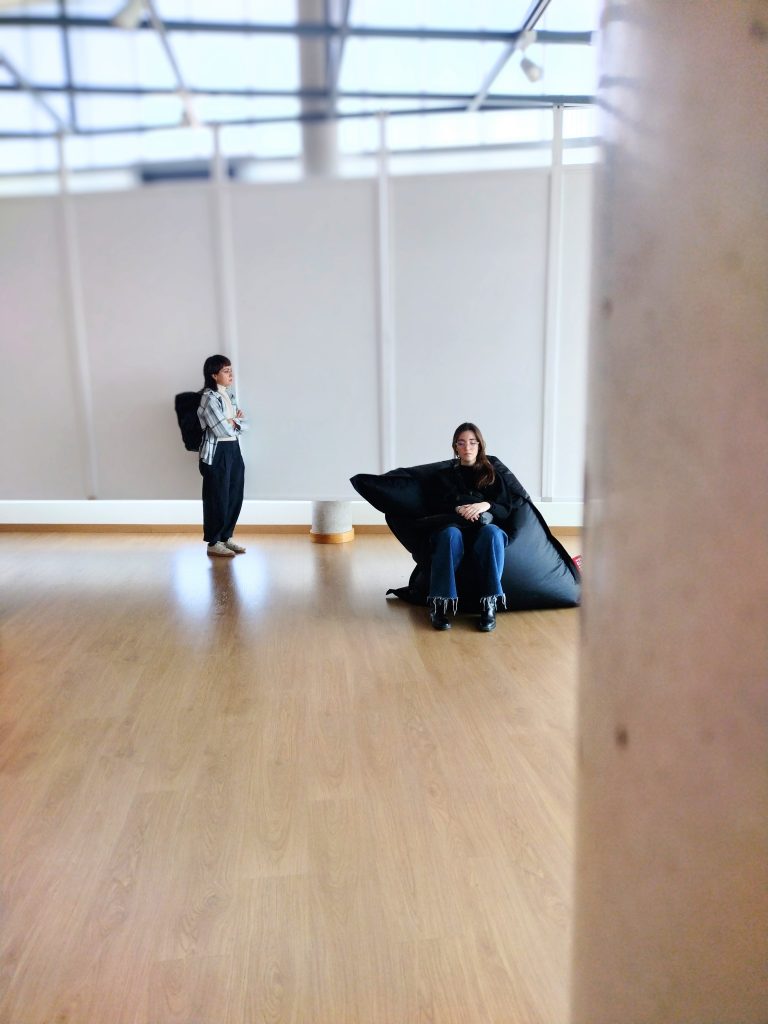
Energies not Forms not Figures, 2023
Rebecca Collins with Adam Matschulat
Digital Audio Piece, 20 minutes in four parts
Energies not Forms not Figures is an audio work in four-parts combining performance writing with field recordings and interview extracts from Rebecca Collins’ visits to the Canfranc Underground Laboratory and to the Astroparticle Acoustic Research Group in Gandia at the Polytechnical University in Valencia. The creative process with Adam Matschulat evolved from an initial conversation over a steamed latte at Café OTO, London in July 2022. Ideas discussed included references to sounds of the everyday that shift reorienting the attention of the listener, the absurd and Samuel Beckett. A conceptual twist to the piece makes use of an excerpt from J.S. Bach’s, Brandenburg Concerto No. 2 in F Major, 1. included on The Sounds of the Earth the Golden Record sent by NASA aboard Voyager I and Voyager II. Whilst the record is intended for the ears of extraterrestrial listeners on unknown planets, Collins and Matschulat, aim to engage the ears of those on planet Earth with the intention of attuning our attention to that which is already around us.
Rebecca Collins is an award-winning artist researcher, whose work focuses on methods of listening, performance, sound, and creative/critical writing.
Adam Matschulat is an award-winning London-based Brazilian composer, sound designer and engineer.
Interview material from conversations with Aaron Vincent, Theopisti Dafni, Carlos Peña Garay.
Composing with Dark Matter, 2022
Ode Aseguinolaza with Rebecca Collins and David Cerdeño //Audiovisual piece for headphones,11 mins 30 seconds // Gold box with brass sensors and mini fan
Composing with Dark Matter is an audiovisual installation for a solitary listener ready to engage in an exclusive encounter with dark matter. The creative process began with an email exchange, in April 2022, requesting Ode Aseguinolaza’s involvement to listen in on the first few minutes of the Universe. Ode accepted, keen to embark on an aurally-inflected intergalactic adventure. A series of online discussions ensued between Rebecca Collins, David Cerdeño, and Ode Aseguinolaza in which the nuances of dark matter detection techniques were discussed and numerical video simulations of the galaxy halo shared. Further details on the seasonal fluxes and wind of dark matter were exchanged, making use of details from the ANAIS experiment, situated 800m below Monte Tobazo at the Canfranc Underground Laboratory. Another clue from the Astroparticle Acoustic Research Group at the Valencia Polytechnic University further informed the format. There, physicists and acousticians explore a bipolar acoustic pulse to sonically search for this elusive particle. International interdisciplinary experiments such as KM3Net and ANTARES study raw acoustic signals recorded on hydrophones situated at a depth of 2.5 km in the Mediterranean Sea aiming to assign an acoustic signature to this invisible energy.
For Composing with Dark Matter Ode Aseguinolaza has prepared a bespoke dark matter detector capable of reacting to these particles circulating in the air surrounding the exhibition space. This system, configured using a series of brass sensors, is able to process and analyse the microscopic particles traversing the gallery offering an audiovisual response adjusted to each individual. Ultimately, in Composing with Dark Matter, the inaudible is rendered audible as the solitary listener attunes their imagination to the mysterious microscopic elements within everyday life.
Ode Aseguinolaza is an artist, composer and performer who lives in France. Classically trained, she studied piano at the conservatory and musicology and composition in Paris.
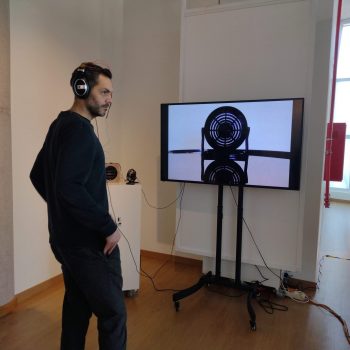
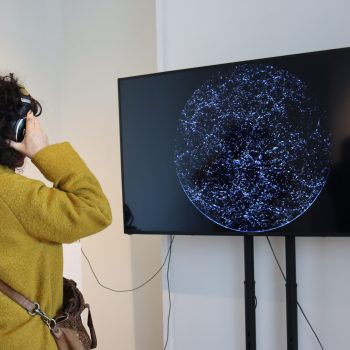

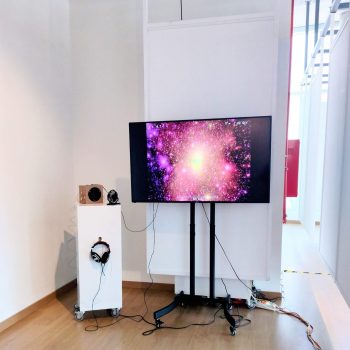
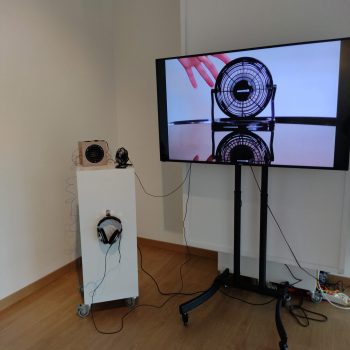
Commissioned Artists: Rebecca Collins, Ode Aseguinolaza, Adam Matschulat, Bricks from the Kiln
Scientific Host: David Cerdeño and the Dark Matter Research Group
Host Institution: Instituto de Fisica Teorica
Funding: Royal Society of Edinburgh Early Career Saltire Fellowship, Artistas en el Campus, UAM
Exhibition realised in collaboration with the Music Laboratory at the Autonoma University: José Luis Carles and Adolfo Nuñez